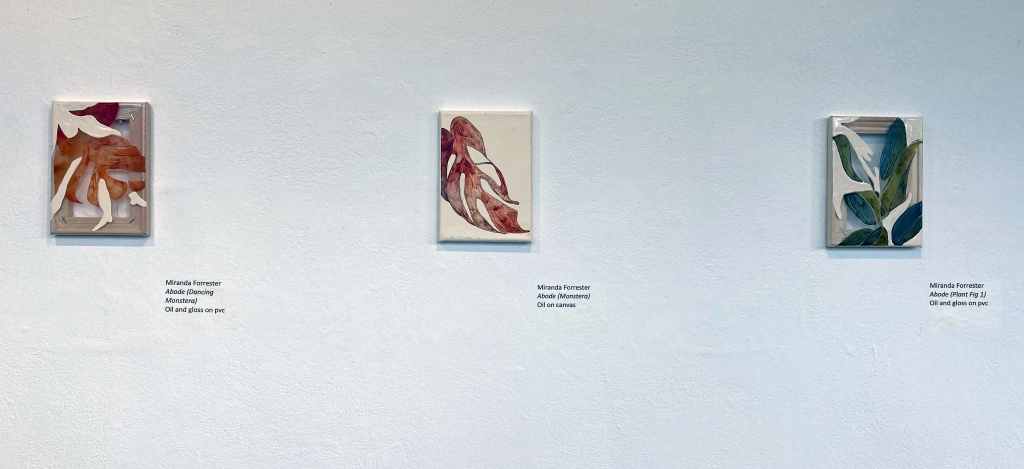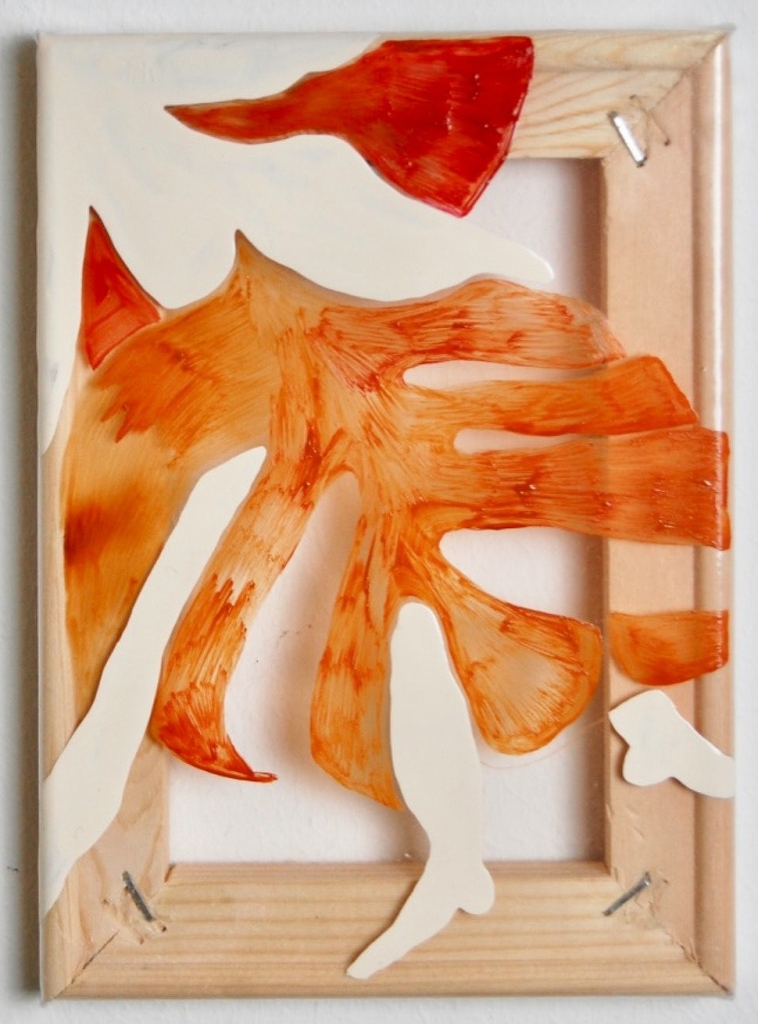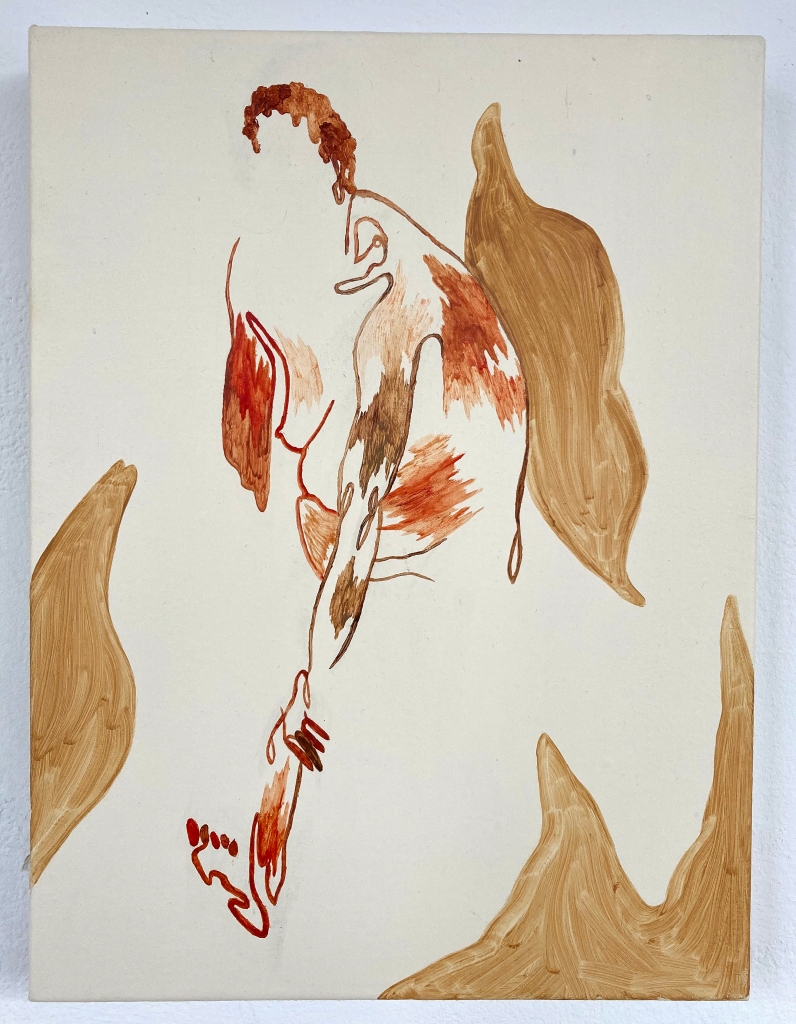Miranda Forrester and Emily Moore
Window Gallery, Phoenix Art Space, Brighton
4-28 February 2021
Currently the best time of day to visit Phoenix Art Space would be at nightfall when the Window Gallery lights illuminate a display of works by Miranda Forrester and Emily Moore as the exhibition is only visible to the public from the outside of the building. Forrester (a painter) and Moore (an illustrator/animator) were awarded a studio residency with support from CASS Art at the Phoenix Art Space after graduating from the University of Brighton in 2019 and this work, a taster of their respective outputs, dates from 2020/21.
As fate would have it, much of Forrester’s and Moore’s time at the Phoenix was overshadowed by the ongoing Covid-19 pandemic. Fortunately their positive resolve to continue to develop their respective practices beyond graduation was maintained and the studio opportunity enabled them to bridge the potentially challenging gap from university life to self-sufficiency and the early stages of promising careers.
For the staff and some permanent studio members of the Phoenix however, there is still the added bonus of being able to see the works closer up as they enter or leave the building. But, as a significant number of the Phoenix community have been unable to visit their studios during the current lockdown restrictions a decision was made to hold the private view for the show as an in-house Zoom meeting. For this event I was asked to present the work to viewers, aided by the Director, Sarah Davies at the computer and Chloe Hoare, the Learning Programme Manager, on iPhone camera duty as she recorded my live talk and the work displayed.
For each of the exhibitors I started the Q&A session by reading out a ‘first impression statement’. What I present here is each statement developed further after the event.
For Emily Moore
“…But the space of thresholds must be distinguished from the concept of a boundary. A threshold’s territory is not exclusive but inclusive. It also includes what might in fact question it. In it mixtures and conflicts occur, but also mutations and rites of passage…” Michele Manzini
From these six framed images I am being introduced to a world bathed in blueness. I like it.
Initially, I read these scenarios as fictive spaces that are manifested from the imagination with the aid of digital technology. A leap from a sub-conscious image bank that appears to have been partly formed by watching films and animations, and maybe comics too. It’s romantic, in a knowingly constructed kind of way. Presenting a dreamscape with an open narrative for the viewer to invent and make sense from. But the reflections on the glass in the frames act as a barrier, at least until I view my photographs of the install later and realise that your scenic locales are not so disembodied from the quotidian space that I think I occupy as a viewer. The two apparent worlds merge.
I return the next day with the reflections in mind and after a while I have a sense of both viewing and entering this unfamiliar land. It seems unknown but commonplace.
It’s not as alien as I first thought. This cinematic space is as real as what is outside the gallery windows now. And vice-versa. Might every-thing outside of the gallery space that is reflected on the blue surfaces (the trees, streetlights, and buildings) be props? The people who stroll past, heading home or towards the beach, despite the cold, are all actors – playing their roles unquestioningly. William Shakespeare was right, after all.
The mundanity of the near empty Brighton streets during this time of lockdown has the potential for enhancing a sense of a shared, communal territory. The gaze into these works employs a combined focus on the pictorial subject matter and, functioning as a rear view mirror onto the world outside. This double view was momentarily quite unnerving. I am not sure I want to look into a mirror too soon.
Your use of distinctive tones and colour contrasts – particularly reds and blues – holds the series together, even if they tell different stories. It has always struck me that the most interesting ‘art’ prompts the viewer to see the world afresh. In the animation still, “Deepwater Café’ there’s a theatre-type space (the trees could be digital coulisse, flat cut-out forms, with blue and red projections suggesting shadow). The Café, a small homely looking construction, looks too small to accommodate very many visitors. The neon ‘Deepwater’ sign looks like it belongs in an urban setting, not in a woodland environment beneath snow-topped mountains. Is this a dream fiction? In such psychological spaces, like the ones we experience in early morning reverie that soon dissipate into the humdrum morning chores, rationality is suspended. This imagery might be built from lived experiences (a film or a family holiday) or render a premonition as yet unrealised. Either way, the scenes are uncannily real and imbue an emotive sense with a subtle quiet humour.
That earlier thought about props and human behaviour comes back, not to haunt, but to revitalise a notion of perception. From seeing your work the viewer might perceive their world to be as constructed as this, as if everything was a toy or commodity of sorts. Not just the small things, but also the complete environment, including the mountains. The point is, that whether intentional or not, seeing your artwork in this setting and context revealed the world to be a sort of construct and a theatre of operations, wherein boundaries are crossed in the imagination and in concrete reality to create a psychogeographic event.When I read your comments about your studies at Brighton I was intrigued by the journey you had made from “experimenting and panicking” in years 1 and 2, and doing what you thought you were supposed to be doing – this is very typical for visual arts students. By the third year you say you were following your “instincts”. You clearly had that ‘threshold experience’ at the right time, in the right place. Make sure that this instinct continues to grow. Nurture it with frustration and doubt if you have to. It’s a crucial element in the creative process.
For Miranda Forrester
“…blackness is a state of being punctuated by thoughtfulness, reflection, intimacy, community, and repose…. Yiadom-Boakye’s conscious decision to create images of black bodies in moments of atemporal pleasure and tranquillity is cathartic.” JaBrea Patterson-West
From viewing the six small paintings I have a sense of the image ‘becoming’ – a kind of re-formation or birth. In the smaller works fragments build rather than deconstruct or diminish. The cut-out shapes and linear content takes on a decorative function with a short-hand, reductive engagement with actual surface and implied forms. The objectness of these three particular works is immediately apparent. Rendered simply and without fuss or detail. There is a minimalist palette of colour: reddish browns, a greyish blue, a pair of greens and a cream white. The light timber stretcher pieces add to the colour scheme. I might have dismissed these first three pieces, as they are so small and I was drawn to the slightly larger canvases. Perhaps they are studies for bigger pieces. Seeing the wood support, and even the staples, suggests that you are stating that there is no need for concealment. The front surface of two of these ‘opened up’ works protrudes barely a couple of centimetres from the white gallery wall surface, creating a space for shadows and this suggests early potential for installation work. Completed pieces are always works in progress.
I am also struck by the smoothness and glossiness of surfaces in all six paintings as if these qualities are as relevant to the visual language as the more obvious, figurative, hand painted areas that depict a figure or a houseplant. The material and the process are in sync with the visual. Smoothness suggests the surface, and touch, of skin, or is this a reference to domestic, comfortable fabrics? The visual aesthetic is serene, simplified, and characteristically linear. Abstract tropes of flatness and painterly colour-shapes affect a visual simplicity. The literal spaces and the glossy smoothness combined with seeing through and between streamlined forms combines the figurative and the abstract nature of shapes.
You are observing the individual figure (perhaps this is your partner) but not voyeuristically. It’s more contemplative than furtive or secretive. It is matter of fact, open and loving. The implied viewer (who, in effect observes you both) takes in a relaxed ambience where there is a feeling of safety and an acceptance of self and other. This is a labile space where spontaneity is accepted and the arousal of emotions is not forced, but is organic. Behaviour is private and safe. But the implied narrative is not neutral. The implicit visual assertion, however visually appealing, is a proclamation of normality for the LGBTQ+ communities that have come to the forefront of culture and politics. This is a positive affirmation for the complexities of human relationships that contrasts with the simplistic binary notion of male/female and the patriarchal and androcentric nature of societies.
The work also raises important questions about art’s subject matter(s) as well as the more broadly cultural and political. The ‘male gaze’ clearly has a dominating history in the tradition of Western art, especially painting. Is this okay, sometimes? So long as we acknowledge that there is a female gaze and a Queer gaze too? Forgive my clumsiness here, for I ask this as a white, heterosexual, sixty-something male who is on a learning curve.
Also, what of the Dancing Monstera in the Abode series? The commonplace Swiss Cheese plants that wilt or gather dust in many living rooms and offices that reveal the legacy of colonial botany under our very noses – was this intentional? The feminist voice encompasses so much more than elemental women’s rights. Let us celebrate diversity in skin colour too. Six little paintings say so much.
Is this a gentle manifesto?
All images © Emily Moore and Miranda Forrester.
Links:
Phoenix Art Space – https://www.phoenixbrighton.org/Events/miranda-forrester-emily-moore/
Phoenix Art Space shop – https://phoenixartspace.selz.com/?_ga=2.238055808.1611813464.1612184337-1267114367.1610537476
Emily Moore – https://blogs.brighton.ac.uk/aadm/2019/05/13/graduate-show-2019-emily-moore-illustration/
Miranda Forrester – https://mirandaforrester.portfoliobox.io
CASS Art – https://www.cassart.co.uk
University of Brighton – https://www.brighton.ac.uk/courses/index.aspx
JaBrea Patterson-West
Quotation from ‘Rest as Revolution: The Speculative Nature of Lynette Yiadom-Boakye’s Figurations’ (Flash Art no.331 Vol.53 Summer 2020)
https://flash—art.com/article/lynette-yiadom-boakyes/
Michele Manzini – Quotation from Instagram
Website – http://www.michelemanzini.com










